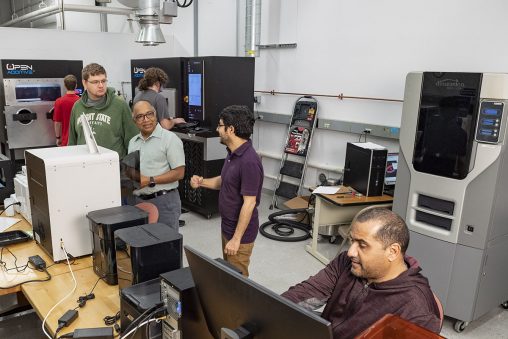
A grant from the Ohio Department of Higher Education will support new training opportunities for Wright State students in the departments of Mechanical and Materials Engineering, Biological Sciences, Nursing, and Kinesiology and Health Sciences. (Photo by Erin Pence)
Wright State University will use a grant from the Ohio Department of Higher Education to purchase equipment that will help students prepare for careers in advanced manufacturing, medical laboratory sciences, nursing and athletic training.
Wright State received a grant of $474,871 in RAPIDS (Regionally Aligned Priorities in Delivering Skills) funds from the State of Ohio to acquire the equipment. The RAPIDS program is designed to encourage regional collaboration, improve Ohio’s workforce development capacity and train workers for jobs that are in high demand in the state.
The funds will be distributed among the departments of Mechanical and Materials Engineering, Biological Sciences, Nursing, and Kinesiology and Health Sciences.
Ahsan Mian, Ph.D., professor of mechanical and materials engineering, is leading the project at Wright State.
The Department of Mechanical and Materials Engineering is using its portion of the RAPIDS grant to bring in additional equipment needed to expand its academic and training programs in advanced manufacturing, additive manufacturing and metrology.
The equipment includes several automated computer numerical control machines, which follow programmed instructions to process material such as metal, plastic or a composite, and a metrology Keyence 3D profilometer, which is used to study the surface of an object.
The equipment will help students develop their skills in computer-aided design (CAD) and computer-aided manufacturing (CAM).
Mian said that thanks to support from grants from the RAPIDS program and other sources, the Department of Mechanical and Materials Engineering has acquired $2 million in equipment over the last several years, giving it the ability to offer more training opportunities in advanced manufacturing techniques to students and professionals.
The department plans to offer new courses, professional certificate programs and specialized short courses in metrology, computer-aided design, computer-aided manufacturing and additive manufacturing that will be available not only to Wright State students but also to working professionals who want to learn new skills.
The department is also developing a new bachelor’s degree in manufacturing.
“Overall, we are developing our manufacturing education capabilities,” said Raghu Srinivasan, Ph.D., professor and chair of the Department of Mechanical and Materials Engineering, who is a licensed professional engineer in the state of Ohio. “These short courses and certificates are possible because of the RAPIDS grants and our new equipment.”
Students in the Medical Laboratory Sciences program will learn to identify microbes and predict those microbes’ susceptibility to antibiotic treatment by training on a Vitek automated system, a cutting-edge tool used in medical laboratories.
The new system will provide students with training on instrumentation they will use in their clinical rotations and in their careers, said Lynn Hartzler, Ph.D., associate professor and chair of the Department of Biological Sciences.
“Having the skill of using a Vitek in hand makes them better prepared for their clinical rotations and opens more time to explore more specialty areas within the medical laboratory sciences,” she said. “Many of our students receive job offers before they earn their degrees, with offers coming from the locations where they are doing their clinical rotations.”
The equipment will also allow the department to expand its Medical Laboratory Sciences program. After training in microbial identification, medical laboratory students will be able to spend more time in clinical rotation positions, giving the program the ability to accept more students.
Nursing and athletic training students will be able to learn more about the human body on a 3D Anatomage table that will be available at both the Dayton Campus and Lake Campus.
The tables will provide students with an interactive 3D human model that can be virtually dissected to explore different layers of the body, different anatomical structures and their functions. In addition, the tables will provide students with the opportunity to observe various surgical procedures and utilize multiple biomedical technologies.
The technology will allow nursing and graduate athletic training students in the School of Nursing, Kinesiology and Health Sciences to closely study human anatomy and learn about diseases and injuries they may encounter in their careers.
“It’s going to give students direct hands-on experience so they can see what’s going on inside of a patient,” said Ann Bowling, Ph.D., associate professor of nursing and assistant chair. “And I think that will be a great opportunity for them.”
Students in Wright State pre-health programs will be able to use the tables as well. The equipment will also be available to high school students who visit the nursing simulation labs during touring campus and STEM events at the Dayton and Lake campuses.

 Wright State psychology team studies ways to identify fatigue in pilots, drivers
Wright State psychology team studies ways to identify fatigue in pilots, drivers  Wright State videographer Kris Sproles wins Regional Emmy and Ohio journalism award
Wright State videographer Kris Sproles wins Regional Emmy and Ohio journalism award  Wright State Boonshoft School of Medicine ranked among the nation’s best for 2024 by U.S. News
Wright State Boonshoft School of Medicine ranked among the nation’s best for 2024 by U.S. News  Exposing biotechnology
Exposing biotechnology  Wright State faculty member Dan Noel uses unique background to inspire new leaders
Wright State faculty member Dan Noel uses unique background to inspire new leaders 